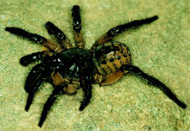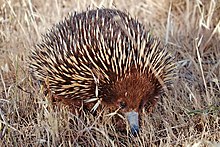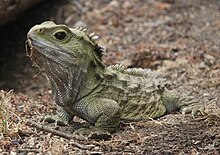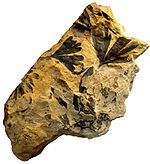Living fossil: Difference between revisions
Burklemore1 (talk | contribs) |
|||
| Line 147: | Line 147: | ||
*** [[Mymarommatidae|Mymarommatid wasps]] (10 living species in genus ''Palaeomymar'') |
*** [[Mymarommatidae|Mymarommatid wasps]] (10 living species in genus ''Palaeomymar'') |
||
*** [[Nevrorthidae]] (3 species-poor genera) |
*** [[Nevrorthidae]] (3 species-poor genera) |
||
*** [[Nothomyrmecia]] (known as the dinosaur ant) |
|||
*** ''[[Notiothauma reedi]]'' (a [[scorpionfly]] relative) |
*** ''[[Notiothauma reedi]]'' (a [[scorpionfly]] relative) |
||
*** [[Orussidae]] (parasitic wood wasps; about 70 living species in 16 genera) |
*** [[Orussidae]] (parasitic wood wasps; about 70 living species in 16 genera) |
||
*** [[Peloridiidae]] (peloridiid bugs; fewer than 30 living species in 13 genera) |
*** [[Peloridiidae]] (peloridiid bugs; fewer than 30 living species in 13 genera) |
||
*** ''[[Sikhotealinia zhiltzovae]]'' (a [[Jurodidae|jurodid]] [[beetle]]) |
*** ''[[Sikhotealinia zhiltzovae]]'' (a [[Jurodidae|jurodid]] [[beetle]]) |
||
*** ''[[Syntexis libocedrii]]'' (Anaxyelidae cedar wood wasp |
*** ''[[Syntexis libocedrii]]'' (Anaxyelidae cedar wood wasp |
||
** '''Crustaceans''' |
** '''Crustaceans''' |
||
*** [[Glypheoidea]] (2 living species: ''Neoglyphea inopinata'' and ''Laurentaeglyphea neocaledonica'') |
*** [[Glypheoidea]] (2 living species: ''Neoglyphea inopinata'' and ''Laurentaeglyphea neocaledonica'') |
||
Revision as of 12:50, 20 May 2015
This article needs additional citations for verification. (January 2011) |

A living fossil is a living species (or clade) of organism that appears to be similar to a species otherwise known only from fossils, typically with no close living relatives. Normally the similarity is only by an imagined physical resemblance, between two different species, one extinct, the other extant. It is an informal non-scientific term, mostly used in the lay media.
These species have survived major extinction events, and generally retain low taxonomic diversities. A species that successfully radiates (forming many new species after a possible genetic bottleneck) has become too successful to be considered a living fossil.
Overview
A subtle difference is sometimes made between a "living fossil" and a "Lazarus taxon". A Lazarus taxon is a taxon (either one species or a group of species) that suddenly reappears, either in the fossil record or in nature (i.e., as if the fossil had "come to life again"), while a living fossil is a species that (seemingly) has not changed during its very long lifetime (i.e., as if the fossil species has always lived). The average species turnover time (the time a species lasts before it is replaced) varies widely among the phyla, but averages about 2–3 million years. So, a living species that was thought to be extinct (e.g., the coelacanth, Latimeria chalumnae) could be called a Lazarus taxon instead of a living fossil. Coelacanths disappeared from the fossil record some 80 million years ago (upper Cretaceous). Of course, species do not just appear out of nothing, so all living Lazarus species (excluding disappearing and reappearing red list species) are nonetheless considered living fossils, if it can be shown they are not Elvis taxa.
Lastly, the term "living fossil" misleadingly appears to suggest that the organism has somehow "stopped evolving". Tadpole shrimp (Triops) are often presented as "living fossils", though a genetic study released in 2013 demonstrated the radiating diversity of notostracans in the genera Triops and Lepidurus: "Our work shows that organisms with conservative body plans are constantly radiating, and presumably, adapting to novel conditions... I would favor retiring the term ‘living fossil’ altogether, as it is generally misleading," the author observed to the popular scientific press.[1] It should be noted that several recent studies pointed out that the morphological conservatism of coelacanths is a myth that is not supported by actual paleontological data.[2][3] In addition, it was shown recently that studies concluding that a slow rate of molecular evolution is linked to morphological conservatism in coelacanths are biased by the a priori hypothesis that these species are ‘living fossils’[4]
Some living fossils are taxa that were known from fossils before living representatives were discovered. The most famous examples of this are the coelacanthiform fishes Latimeria chalumnae and Latimeria menadoensis and the dawn redwood, Metasequoia, discovered in a remote Chinese valley. Others include glypheoid lobsters, mymarommatid wasps, eomeropid scorpionflies, and jurodid beetles, all of which were first described from fossils, but later found alive (2 species, 10 species, one species, and one species respectively). Others are a single living species that has no close living relatives, but is the survivor of a large and widespread group in the fossil record. Perhaps the best-known example is Ginkgo biloba, though there are others, such as Syntexis libocedrii (the cedar wood wasp).The dinoflagellate Dapsilidinium pastielsii is also such an example, which was first described as a fossil dinocyst from the Eocene.[5]
Note that just because a living fossil is a surviving representative of an archaic lineage does not necessarily require that it retains all of the "primitive" features (plesiomorphies) of the lineage it is descended from; that is, they may possess one to many derived features (autapomorphies), that have evolved since the time of their lineage's divergence. All that is required is that they can be unambiguously assigned to an otherwise extinct lineage (rarely are they identical to the fossil forms). See for example the uniquely and highly autapomorphic oxpeckers, which are not "true" living fossils (as no fossils are known yet) but nonetheless appear to be the only survivors of an ancient lineage related to starlings and mockingbirds.[6]
History
The term was coined by Charles Darwin in his On the Origin of Species, when discussing Ornithorhynchus (the platypus) and Lepidosiren (the South American lungfish):
... All fresh-water basins, taken together, make a small area compared with that of the sea or of the land; and, consequently, the competition between fresh-water productions will have been less severe than elsewhere; new forms will have been more slowly formed, and old forms more slowly exterminated. And it is in fresh water that we find seven genera of Ganoid fishes, remnants of a once preponderant order: and in fresh water we find some of the most anomalous forms now known in the world, as the Ornithorhynchus and Lepidosiren, which, like fossils, connect to a certain extent orders now widely separated in the natural scale. These anomalous forms may almost be called living fossils; they have endured to the present day, from having inhabited a confined area, and from having thus been exposed to less severe competition.
Other definitions
Other definitions denoting living fossils:
- A living taxon that lived through a large portion of geologic time.[citation needed]

Elephant Shrews resemble the extinct Leptictidium of Eocene Europe.
- To prove this, all living specimens must belong to the same fossil species. This rules out Limulus, Peripatus, Latimeria, Sphenodon, Didelphis, the platypus, and many others. To allow some flexibility, the genus could be used. Paleontological taxonomy relies on hard-part morphology (the paleontological species concept), so there is a bias towards longer species turnover times, and relationships can only be inferred partially. Modern molecular biology has shown that genetic rates of change are relatively uniform and not well related to morphological change rates. So from a more molecular basis of interbreeding capabilities there are essentially no such thing as species that lived through a long geological time. However, with the proviso that we are using the special case of a paleontological species name, the definition does hold together in context. Queensland lungfish (Neoceratodus fosteri) is an example of an organism that meets this criteria, fossils identical to modern Queensland lungfish have been dated at over 100 million years making this species one of the oldest if not actually the oldest extant vertebrate species.
- A living taxon morphologically and/or physiologically resembling a fossil species through a large portion of geologic time (morphological stasis).[8]
- The living specimens need not belong to the same fossil species (or even genus). There must at least be some physiological resemblance.
- The coelacanth for example, is a marine fish. The Mesozoic coelacanth species lived in salt and fresh water. Osmoregulation in Latimeria is handled by urea retention. Urea retention is considered to indicate fresh water ancestry. This means that the coelacanth lineage evolved from freshwater to saltwater.
- The resemblance between Peripatus and Aysheaia (an early Cambrian animal from the Burgess Shale) would be striking (both are classified in the Tardipolypoda (Tardigrada and Onychophora), were it not that Aysheaia was a marine animal, while Peripatus lives in tropical leaf mould.
- A living taxon with many primitive characteristics.[citation needed]
- This is a more neutral definition. However, it does not make it clear whether the taxon is truly old, or it simply has many plesiomorphies. Note that, as mentioned above, the converse may hold for true living fossil taxa; that is, they may possess a great many derived features (autapomorphies), and not be particularly "primitive" in appearance.

More primitive trapdoor spiders, such as this female Liphistius sp., have segmented plates on the dorsal surface of the abdomen and cephalothorax, a character shared with scorpions, making it probable that after the spiders diverged from the scorpions, the earliest unique ancestor of trapdoor species was the first to split off from the lineage that contains all other extant spiders.
- Any one of the above three definitions, but also with a relict distribution in refuges.[citation needed]
- Some paleontologists believe that living fossils with large distributions (such as Triops cancriformis) are not real living fossils. In the case of Triops cancriformis (living from the Triassic until now), the Triassic specimens lost most of their appendages (mostly only carapaces remain), and they have not been thoroughly examined since 1938.
- Any of the first three definitions, but the clade also has a low taxonomic diversity (low diversity lineages).[citation needed]
- Oxpeckers are morphologically somewhat similar to starlings due to shared plesiomorphies, but are uniquely adapted to feed on parasites and blood of large land mammals, which has always obscured their relationships. This lineage forms part of a radiation that includes Sturnidae and Mimidae, but appears to be the most ancient of these groups. Biogeography strongly suggests that oxpeckers originated in eastern Asia and only later arrived in Africa, where they now have a relict distribution.[6] The two living species thus seem to represent an entirely extinct and (as Passerida go) rather ancient lineage, as certainly as this can be said in the absence of actual fossils. The latter is probably due to the fact that the oxpecker lineage never occurred in areas where conditions were good for fossilization of small bird bones, but of course, fossils of ancestral oxpeckers may one day turn up enabling to test this theory.
An organism's living fossil status can be rejected if the (smallest) clade the species belongs to is species rich, as this would imply (recent) speciation.
Examples

Some of these are informally known as "living fossils".
Bacteria
- Stromatolite, a layered structure created as sediment is trapped by shallow-water, oxygen-creating, blue-green bacteria
Protists
- The dinoflagellate Dapsilidinium pastielsii.[5]
- The coccolithophore Tergestiella adriatica
Plants
- Amborella – a plant from New Caledonia, possibly closest to base of the flowering plants
- Araucaria araucana – the monkey puzzle tree
- Cycads
- Ginkgo tree (Ginkgoaceae)
- Horsetails – Equisetum (Equisetaceae)
- Metasequoia – dawn redwood (Cupressaceae; a borderline example, related to Sequoia and Sequoiadendron)
- Sciadopitys tree (Sciadopityaceae)
- Sycamore tree - leaves of fossil sycamores have an incredibly similar phenotype to those living today
- Whisk ferns – Psilotum (Psilotaceae)
- Welwitschia (Welwitschiaceae)
- Wollemia tree (Araucariaceae – a borderline example, related to Agathis and Araucaria)[10][11]
Fungi
Animals
- Vertebrates

Echidnas are one of few mammals to lay eggs. 
Hoatzin are born with two visible claws on their wings, but the claws fall out once the birds reach maturity. 
Crocodilians survived the K–Pg extinction event that killed off the dinosaurs. 
Tuataras are reptiles, yet retain more primitive characteristics than lizards and snakes. - Mammals
- Aardvark (Orycteropus afer)
- Amami rabbit (Pentalagus furnessi)[citation needed]
- Chevrotain (Tragulidae)[citation needed]
- Elephant shrew (Macroscelidea)[citation needed]
- Laotian rock rat (Laonastes aenigmamus)[citation needed]
- Monito del Monte (Dromiciops gliroides)
- Monotremes (the platypus and echidna)
- Mountain beaver (Aplodontia rufa)
- Okapi (Okapia johnstoni)[12]
- Opossums (Didelphidae)
- Capybara (Hydrochoerus hydrochaeris)[citation needed]
- Pygmy right whale (Caperea marginata)[citation needed]
- Red panda (Ailurus fulgens)[citation needed]
- Solenodon (Solenodon cubanus and Solenodon paradoxus)
- Shrew opossum (Caenolestidae)
- Cetaceans
- False killer whale (Pseudorca crassidens)
- Birds
- Pelicans have been virtually unchanged since the Eocene, and are noted to have been even more conservative across the Cenozoic than crocodiles[13]
- Acanthisittidae (New Zealand "wrens") – 2 living species, a few more recently extinct. Distinct lineage of Passeriformes.
- Broad-billed sapayoa (Sapayoa aenigma) – One living species. Distinct lineage of Tyranni.
- Bearded reedling (Panurus biarmicus) – One living species. Distinct lineage of Passerida or Sylvioidea.
- Coliiformes (mousebirds) – 6 living species in 2 genera. Distinct lineage of Neoaves.
- Hoatzin (Ophisthocomus hoazin) – One living species. Distinct lineage of Neoaves.
- Magpie goose (Anseranas semipalmata) – One living species. Distinct lineage of Anseriformes.
- Seriema (Cariamidae) – 2 living species. Distinct lineage Cariamae.
- Tinamiformes (tinamous) 50 living species Distinct Lineage Palaeognathae
- Reptiles
- Alligator snapping turtle (Macrochelys temminckii)
- Crocodilia (crocodiles, gavials, caimans and alligators)
- Pig-nosed turtle (Carettochelys insculpta)
- Snapping turtle (Chelydra serpentina)
- Tuatara (Sphenodon punctatus and Sphenodon guntheri)
- Amphibians
- Giant salamanders (Cryptobranchus and Andrias)
- Hula painted frog (Latonia nigriventer)[14]
- Purple frog (Nasikabatrachus sahyadrensis)
- Jawless fish
- Hagfish (Myxinidae) Family
- Bony fish
- Arowana and arapaima (Osteoglossidae)
- Bowfin (Amia calva)
- Coelacanth (the lobed-finned Latimeria menadoensis and Latimeria chalumnae)
- Gar (Lepisosteidae)
- Queensland lungfish (Neoceratodus fosteri)
- Sturgeons and paddlefish (Acipenseriformes)
- Bichir (Polypteridae) family
- Protanguilla palau
- Mudskipper (Oxudercinae)
- Sharks
- Blind shark (Brachaelurus waddi)
- Bullhead shark (Heterodontus sp.)
- Elephant shark (Callorhinchus milii)
- Frilled shark (Chlamydoselachus sp.)
- Goblin shark (Mitsukurina owstoni)
- Gulper shark (Centrophorus sp.)
- Mammals
- Invertebrates

Nautilus still retain the external, spiral shell that its other relatives have lost. 
With little change over the last 450 million years, the horseshoe crabs appear as living fossils - Insects
- Mantophasmatodea (gladiators; a few living species)
- Meropeidae (3 living species, 4 extinct)
- Micromalthus debilis (a beetle)
- Mymarommatid wasps (10 living species in genus Palaeomymar)
- Nevrorthidae (3 species-poor genera)
- Nothomyrmecia (known as the dinosaur ant)
- Notiothauma reedi (a scorpionfly relative)
- Orussidae (parasitic wood wasps; about 70 living species in 16 genera)
- Peloridiidae (peloridiid bugs; fewer than 30 living species in 13 genera)
- Sikhotealinia zhiltzovae (a jurodid beetle)
- Syntexis libocedrii (Anaxyelidae cedar wood wasp
- Crustaceans
- Glypheoidea (2 living species: Neoglyphea inopinata and Laurentaeglyphea neocaledonica)
- Stomatopods (mantis shrimp)
- Triops cancriformis (also known as tadpole shrimp; a notostracan crustacean)
- Molluscs
- Other invertebrates
- Crinoids
- Horseshoe crabs (only 4 living species of the class Xiphosura, family Limulidae: Limulus polyphemus,Tachypleus gigas, Tachypleus tridentatus and Carcinoscorpius rotundicauda)
- Lingula anatina (an inarticulate brachiopod)
- Liphistiidae (trapdoor spiders)
- Onychophorans (velvet worms)
- Valdiviathyris quenstedti (a craniforman brachiopod)
- Paleodictyon nodosum (unknown)
- Dendrogramma (not definitively assigned to any existing phylum, bears a strong resemblance to Ediacaran biota organisms)
- Insects
See also
References
- ^ "Diversification in Ancient Tadpole Shrimps Challenges the Term 'Living Fossil'" Science Daily accessed 2 April 2013; "The Falsity of 'Living Fossils'", The Scientist] accessed 2 April 2013.
- ^ Friedman M, Coates MI, Anderson P; Coates; Anderson (2007). "First discovery of a primitive coelacanth fin fills a major gap in the evolution of lobed fins and limbs". Evolution & Development. 9 (4): 329–37. doi:10.1111/j.1525-142X.2007.00169.x. PMID 17651357.
{{cite journal}}: CS1 maint: multiple names: authors list (link) - ^ Friedman M, Coates MI; Coates (2006). "A newly recognized fossil coelacanth highlights the early morphological diversification of the clade". Proc. R. Soc. B. 273 (1583): 245–250. doi:10.1098/rspb.2005.3316. PMC 1560029. PMID 16555794.
- ^ Casane D, Laurenti P; Laurenti (Feb 2013). "Why Coelacanths are not "Living fossils" : a Review of Molecular and Morphological Data". BioEssays. 35 (4): 332–8. doi:10.1002/bies.201200145. PMID 23382020.
- ^ a b Mertens, K.N.; Takano, Y.; Head, M.J.; Matsuoka, K. (2014). "Living fossils in the Indo-Pacific warm pool: A refuge for thermophilic dinoflagellates during glaciations". Geology. 42 (6): 531–534. doi:10.1130/G35456.1.
- ^ a b Dario Zuccon, Anne Cibois, Eric Pasquet & Per G. P. Ericson; Cibois; Pasquet; Ericson (2006). "Nuclear and mitochondrial sequence data reveal the major lineages of starlings, mynas and related taxa" (PDF). Molecular Phylogenetics and Evolution. 41 (2): 333–344. doi:10.1016/j.ympev.2006.05.007. PMID 16806992.
{{cite journal}}: CS1 maint: multiple names: authors list (link) - ^ On the Origin of Species, 1859, p. 107.
- ^ "The University of Chicago Medical Center: Scientists find lamprey a 'living fossil' ". Uchospitals.edu. 2006-10-26. Retrieved 2012-05-16.
- ^ Hagino, K.; Young, J. R.; Bown, P. R.; Godrijan, J.; Kulhanek, D.; Kogane, K.; Horiguchi, T. (2015). "Re-discovery of a "living fossil" coccolithophore from the coastal waters of Japan and Croatia". Marine Micropaleontology. 116 (1): 28–37. doi:10.1016/j.marmicro.2015.01.002.
- ^ Chambers, T.C.; Drinnan, A.N.; McLoughlin, S. (1998). "Some morphological features of Wollemi Pine (Wollemia nobilis: Araucariaceae) and their comparison to Cretaceous plant fossils". International Journal of Plant Science. 159: 160–171. doi:10.1086/297534.
- ^ McLoughlin S., Vajda V.; Vajda (2005). "Ancient wollemi pines resurgent". American Scientist. 93 (6): 540–547. doi:10.1511/2005.56.981.
- ^ "Why Is the Okapi Called a Living Fossil". The Milwaukee Journal. Jun 24, 1954.
- ^ Switek, Brian. "Repost: The Pelican's Beak - Success and Evolutionary Stasis | Wired Science". Wired.com. doi:10.1007/s10336-010-0537-5. Retrieved 2013-06-10.
- ^ Morelle, Rebecca. "Rediscovered Hula painted frog 'is a living fossil'". BBC News. Retrieved 4 June 2013.











